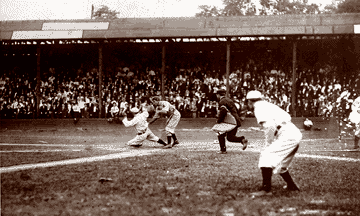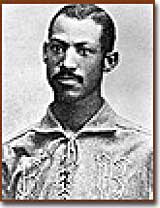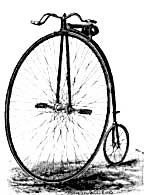39b. Sports and Leisure

A sports craze was sweeping the nation. Work weeks were still long, averaging about sixty hours per week in 1890. But the average worker notched 66 hours in 1860, giving the typical American six extra hours of free time each week. Three more decades would see an additional 10 hours of average working time turn into free time.
What did Americans do with all this time? Participation in sports, leisure, and amusement activities multiplied.
Take Me out to the Ball Game
Baseball was quickly becoming the national pastime. It had graduated from a gentleman's game to a form of mass entertainment. As cities and towns dedicated more and more public land for recreational purposes, baseball became more and more popular. Those who did not enjoy playing were given the opportunity to watch.

Moses Fleetwood Walker was the first African-American to play on a major league baseball team (the Toledo Blue Stockings).
The National League was formed in 1876 and Americans were able to watch touring professionals play the game. As a color barrier had been quickly established, not all athletes were given an opportunity. The National League and its rival, the American League, played for the first World Series Championship in 1903. The baseball craze led to the financing of large grandstand arenas such as Fenway Park in Boston, Shibe Park in Philadelphia, and Wrigley Field in Chicago.
Other spectator sports were also popular. Football had a large following, particularly on the college level. Universities were accused of hiring ringers (professionals) to help them win games. The rules were fairly lax, and many injuries resulted. In 1905, eighteen players were killed by injuries related to football.
Boxing became more respectable with a new innovation — gloves. Basketball was invented in 1891 in Springfield, Massachusetts by James Naismith, a YMCA instructor. Designed as an indoor sport, basketball enabled athletic competition during the winter months. Croquet and tennis provided the only opportunity in sport for coed play.
Vaudville
Other forms of mass entertainment also flourished. The most popular form of urban performance was the vaudeville show. An evening at vaudeville might last two or three hours, as audiences watched nine or ten different acts, ranging from singing and dancing to stand-up comedy and acrobatics. The first vaudeville theater was opened in 1881 by Tony Pastor in Manhattan. Eventually, New York had ten vaudeville theaters, and every major city could boast at least one.
For the children, Phineas T. Barnum and James A. Bailey presented "The Greatest Show on Earth," a three-ring circus complete with exotic animals, trapeze artists, and big tent.
Age of the Bicycle

The velocipede became popular in the later half of the 19th century. While the larger front wheel allowed for greater speed, the potential fall was quite dangerous.
On an individual level, the turn of the century was also the age of the bicycle. In 1885, the velocipede, a "bicycle" with one huge wheel followed by a smaller one, became instantly obsolete when the safer, modern bicycle with two wheels of equal size made its debut.
Many became addicted to this new form of exercise. Men and women took romantic rides through parks, and courtship took a step closer to independence from parental involvement.
The bicycle even had an impact on women's fashion. No one could ride around on a bicycle with a big Victorian hoop dress, so designers accommodated the new trend by producing a freer, less constrictive style.






